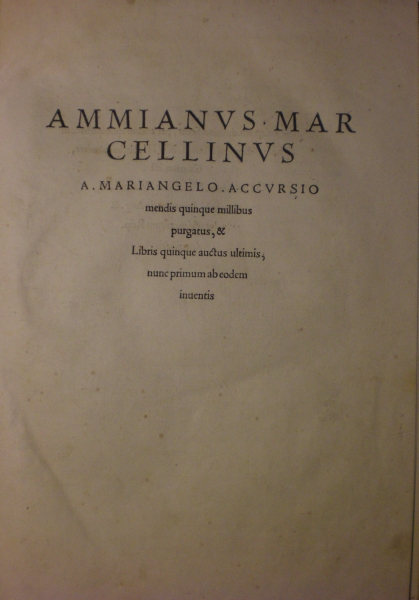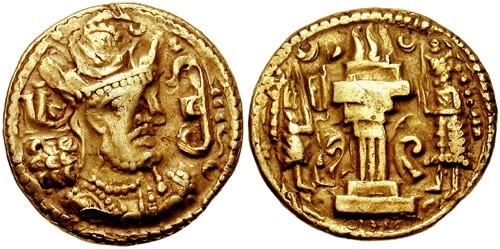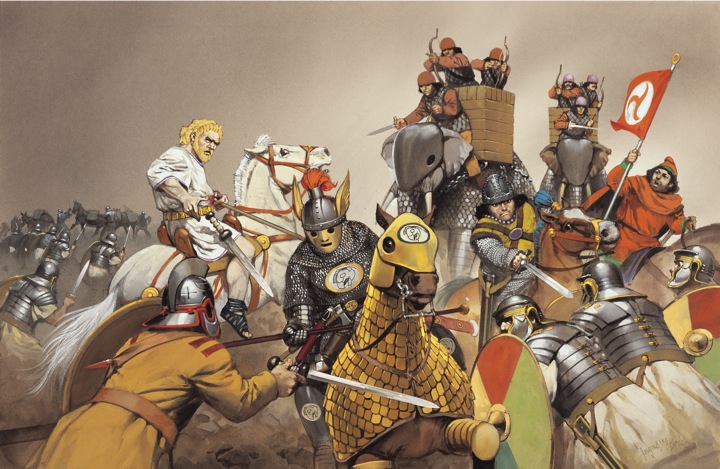The article below by M. L. Chaumont on “Ammianus Marcellinus” on the Encyclopedia Iranica was originally published on December 15, 1989 and last updated on August 3, 2011. This article is also available in print (Vol. I, Fasc. 9, pp. 977-979). Kindly note that the images and accompanying captions do not appear in the original Encyclopedia Iranica article.
===============================================================
Ammianus Marcellinus, historian who provides important information on the Sasanians. Born ca. 330-35 in Antioch on the Orontes to a wealthy family of Greek origin, he received a bilingual education in Greek and Latin. Toward 350 he entered the elite group of the protectores domestici and was appointed to the staff of the general Ursicinus. He took part in the Roman Mesopotamian campaign and in the operations at Amida in 359; four years later, he accompanied the Emperor Julian on his disastrous expedition against the Persians. Following these events, he abandoned his military career and retired to Antioch. Toward 380, after having traveled in Egypt and Greece, he settled in Rome, where he composed his historical work in Latin. He was still alive in 392; it is thought that he died ca. 395. He calls himself Graecus (31.16.9) but, shaped at an early age by the army, he was acting as a typical Roman. In religion, he was pagan. His Res Gestae originally consisted of thirty-nine books; the first thirteen, which covered the period from 93 to 353 A.D., including the Parthian Wars, have disappeared. The remaining books covering the period from 353 to 378, are important for the history of the Sasanian empire in the 4th century. The author expresses himself in the obscure and labored Latin typical of the late empire.

Cover page of text by Greco-Roman historian Ammianus Marcellinus published in Augsburg in 1533 (Source: Photograph by Feldkurat Katz in Public Domain).
Ammianus was solidly prejudiced against the Persians, whom he considered the hereditary enemies of the Roman Empire. Though he did not know their language, he provides abundant and valuable information on the history of the reign of Šāpūr II, particularly between 353 and 363. As a protector, he was in a good position to obtain first-hand information, whether through conversations with Ursicinus and other military personalities, or through staff reports based on statements of scouts, spies, or deserters. He seems to have received information on the Persian-Roman negotiations of 354-63 from those actually involved. He shows himself equally well informed about the bodyguard Antonius, who went over to the enemy camp, received from Šāpūr the honor of wearing a tiara, and eventually became his mentor (Res Gestae 17.5.1-3, 6-8; 6.3). Ammianus had access to official documents, e.g., the famous letter of Šāpūr II to Constantine (17.5.3-9). In 539 he was sent to contact Iovinianus, the Sasanian satrap of Gordyene, and during this mission he could see from a mountaintop the Persian troops proceeding toward Amida (18.6.21-22). Then he personally participated in the defense of Amida when it was invested by the Persians (July-October, 359) and provides many first-hand accounts of the siege, which was to end in disaster for the Romans. He describes carefully the tactics of the Persians, their war machines (earthworks, high towers studded with iron spikes, etc.), their arms, which were so different from those of the Romans (suits of scale armor [cataphracts], shields of woven wicker covered with untanned skins, etc.), and even their shouts. He details the arrival of Šāpūr in Amida at the head of his troops; mounted, he surpassed all his companions in height and wore a ram’s head crown. He was followed by a royal escort (19.1.1-5) and accompanied by two of his vassals, the king of Albania and Grumbates, king of the Chionites. Behind came the Persian soldiers, saluting their sovereign with cries of saansaan (šāhānšāh “king of kings”) and pirosen (pērōz “victorious” [19.2.11]).

Golden coin of Shapur II (Source: The Classical Numismatic Group in Public Domain).
In the narration of the campaigns of 363, the Persian army is described drawn up in battle formation under the command of Merana (Mehrān), the general of the cavalry. There were cataphractarii, lancers, archers, and a line of war elephants (25.1.10). Perhaps Ammianus was personally acquainted with the prince Ormizdas (Hormizd), the elder brother of Šāpūr II, who fled his country, took refuge in Roman territory and, in 363, served in Julian’s army; he often alludes to his delicate position (16.10.16; 24.1.2, 8; 2.4, 11, 20; 5.4; 26.8.12). Ammianus appears to be well informed about the places through which Julian’s army marched on its way to Ctesiphon in 363 (cf. Dillemann, in Syria 28, 1962, p. 101). He names most of the Persian strongholds, giving more precise information on some, e.g., Maiozamalcha or Pirisabora (Pērōz-Šāpūr), one of the principal storehouses of the kingdom, where the Romans found an abundance of arms and supplies (24.2.9ff.). Before arriving at Coche (Seleucia or Weh-Ardašīr), Ammianus was able to contemplate a royal palace “constructed in the Roman fashion,” with a large park stocked for the king’s hunt (24.5.1-2). At the gates of Coche was seen “a shaded and pleasant residence,” on the walls of which were depicted the royal hunts (24.6.3). These items are valuable for the topography of Seleucia (cf. G. Gullini, in Mesopotamia 1/1, 1966 pp. 28ff.).

Emperor Julian is killed during his failed invasion of Sassanian Persia in June 26, 363 AD. Above is a recreation of Sassanian Persia’s elite cavalry, the Savaran, as they would have appeared during Julian’s failed invasion. Note the heavily armored Sassanian elite guardsman (Pushtighban) whose lance has pierced a Roman infantryman. Further right is a Savaran officer whose sword is drawn in what is now known as the “Italian grip” but Sassanian in origin. To the far right can be seen a Zoroastrian or Mithraist Magus brandishing a Sassanian era symbol. Also of interest are the armored elephants in the background. Armored elephants were especially prized as their cabs afforded very high elevation over the battlefield, which was ideal for Sassanian archery (Picture source: Farrokh, Plate D, Elite Sassanian cavalry, 2005).
For the period after 363, and especially on the war between Iran and Armenia (supported by Rome), Ammianus’ work is the most reliable source of information. He describes, e.g., the long siege of Artogerassa (Artagerkʿ) by the troops of Šāpūr in 369-70 (27.12.5-9) but he only alludes to the battle of Vagabanta (Bagavan in Bagravand) in 371 (29.1.3). He helps establish with relative certainty the general chronology of the affairs of Armenia from 354 to ca. 378 (cf. N. Baynes, “Rome and Armenia in the Fourth Century,” English Historical Review 25, 1910, pp. 632ff.).
A recreation of Emperor Julian’s failed invasion of the Sassanian Empire in 363 CE (Source: Karzar Nameh in Youtube).
Ammianus has left us a methodical and detailed picture of the Persian empire (23.6.1-74), dividing it into eighteen major provinces (maiores provinciae). For each region or province, he conscientiously names principal cities, rivers, and mountains, without neglecting distinctive local features. But for this material he relied largely on pre-Sasanian written sources, e.g., Ptolemy and Strabo (cf. Dillemann, Syria 28, 1961, pp. 135ff.; Gagé, La montée des Sassanides, Paris, 1964, pp. 167, 170). Thus he speaks anachronistically of the Arsacid dynasty as if it were still in power (23.6.5-6). The reference to vitaxes (bidaxš), vassal kings, or satraps at the head of the “principal provinces” (regiones maximae, 23.6.14) could likewise reflect the Parthian period. Ammianus frequently uses the term “Parthians” to describe the Persians of his own day, but this error is common to other historians. He also makes geographical errors (e.g., placing Ecbatana in Adiabene).
Bibliography
Editions: Editio princeps (incomplete, with errors) by Angelus Sabinus, Rome, 1474.
V. Gardthausen, Leipzig, 1875 (Teubner ed.).
C. V. Clark et al., two vols., Berlin, 1910-15.
John C. Rolfe, with an English translation (Loeb Classical Library), three vols., London and Cambridge, Mass., 1935-39.
E. Galletier et al., Paris, 1968.
W. Seyfarth, 1-2, Leipzig, 1978.
Studies: H. Sudhaus, De ratione quae inrercedat inter Zosimi et Ammiani de bello a Juliano imperatore cum Persis gesto relationes, diss., Bonn, 1870.
V. Gardthausen, “Die geographischen Quellen Ammians,” Fleckeisens Jahrbuch, Suppl. 6, 1873.
G. Reinhardt, “Der Perserkrieg des Kaisers Julian,” X Jahresbericht des herzogl. Friedr. Realgymnasium für das Jahr 1891-92.
O. Seeck, “Ammianus” (Nr. 4), Pauly-Wissowa, I, 1894, cols. 1845-52.
Idem, “Zur Chronologie und Quellenkunde des Ammianus Marcellinus,” Hermes 40, 1914.
L. Dautremer, “Ammien Marcellin,” Travaux et Mémoires de l’Université de Lille 7, Mém. 23, 1899.
T. Mommsen, “Ammians Geographica,” Gesammelte Schriften 7, Berlin, 1909, p. 393.
A. Klotz, “Die Quellen Ammianus in der Darstellung von Julians Perserzug,” Rheinisches Museum für Philologie 71, 1916.
G. B. Pighi, “Studia Ammianea. Annotationes criticae et grammaticae,” Pubblicazioni Università cattolica del Sacro Cuore 20, Milan, 1935.
Idem, “Nuovi Studi Ammianei,” ibid., 21, 1936.
E. A. Thompson, The Historical Work of Ammianus Marcellinus, Cambridge, 1947.
E. Herzfeld, Geschichte der Stadt Samarra, Hamburg, 1948, pp. 63-70.
M. I. A. Brok, De perzische Expeditie van Keizer Julianus volgens Amm. Marcell., Groningen, 1959.
L. Dillemann, “Ammien Marcellin et les pays du Tigre et de l’Euphrate,” Syria 28, 1961, pp. 87-158.
M. Fuhrmann, “Ammianus Marcellinus,” Der Kleine Pauly I, 1964, cols. 302-04.
H. T. Rowell, Ammianus Marcellinus, Soldier-Historian of the Late Roman Empire, Cincinnati, 1964.
R. Syme, Ammianus and the Historia Augusta, Oxford, 1968.
A. H. M. Jones, The Prosopography of the Later Roman Empire I, Cambridge, 1971, pp. 547-48.
G. A. Crump, Ammianus Marcellinus as a Military Historian, Wiesbaden, 1975.
R. C. Blockley, Ammianus Marcellinus: A Study of his Historiography and Political Thought, Brussels, 1975.[/fusion_builder_column][/fusion_builder_row][/fusion_builder_container]



